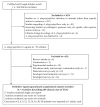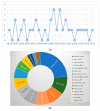Equine Granulocytic Anaplasmosis: A Systematic Review and Meta-Analysis on Clinico-Pathological Findings, Diagnosis, and Therapeutic Management
- PMID: 38922016
- PMCID: PMC11209296
- DOI: 10.3390/vetsci11060269
Equine Granulocytic Anaplasmosis: A Systematic Review and Meta-Analysis on Clinico-Pathological Findings, Diagnosis, and Therapeutic Management
Abstract
Equine granulocytic anaplasmosis (EGA) is a tick-borne disease affecting horses worldwide, caused by Anaplasma phagocytophilum. The disease ranges from non-specific clinical signs to fatal outcomes. This paper aimed to analyze EGA cases reported in peer-reviewed journals, particularly on clinico-pathological findings, diagnosis, and therapeutic management. Overall, 189 clinical cases from 31 publications were included in the study. Extensive symptomatology for the EGA cases was reported, of which mostly was fever (90.30%), followed by limb edema (48.51%), anorexia (41.79%), depression (32.84%), icterus (22.39%), ataxia (17.91), tachycardia (16.42%), and lethargy (15.67%). Laboratory tests revealed thrombocytopenia (90.32%), anemia (75%), decreased hematocrit (70.59%), leukopenia (55.88%), lymphopenia (58.14%), and neutropenia (41.67%) as the most common hematological abnormalities. For a subset of tested animals, hyperbilirubinemia (20/29), hyperfibrinogenemia (13/15), and hyponatremia (10/10) were also reported. The diagnosis was established by microscopic identification of morulae (in 153 cases), and/or PCR (120 cases), isolation (1 case), or serology (56 cases). For treatment, oxytetracycline was used in the majority (52.24%) of EGA cases, but recovery without antibiotherapy (10.34%) was also noted. In conclusion, the variety of clinical and pathological findings and the challenging therapeutic approaches reported suggest that EGA should be included in the differential diagnosis when fever occurs.
Keywords: Anaplasma phagocytophilum; clinico-pathology; diagnosis and treatment; equine granulocytic anaplasmosis.
Conflict of interest statement
The authors declare no conflicts of interest.
Figures


Similar articles
-
First molecular evidence of equine granulocytic anaplasmosis in Pakistan.Acta Trop. 2018 Apr;180:18-25. doi: 10.1016/j.actatropica.2017.12.032. Epub 2018 Jan 5. Acta Trop. 2018. PMID: 29306724
-
Equine Granulocytic Anaplasmosis 28 years later.Microb Pathog. 2018 Jun;119:1-8. doi: 10.1016/j.micpath.2018.04.001. Epub 2018 Apr 4. Microb Pathog. 2018. PMID: 29626656 Review.
-
Equine granulocytic anaplasmosis in the Czech Republic.Vet Rec. 2010 May 22;166(21):646-9. doi: 10.1136/vr.4852. Vet Rec. 2010. PMID: 20495165
-
CLINICAL DISEASE ASSOCIATED WITH ANAPLASMA PHAGOCYTOPHILUM INFECTION IN CAPTIVE PRZEWALSKI'S HORSES (EQUUS FERUS PRZEWALSKII).J Zoo Wildl Med. 2017 Jun;48(2):497-505. doi: 10.1638/2016-0247R.1. J Zoo Wildl Med. 2017. PMID: 28749289
-
[Equine anaplasmosis and equine piroplasmosis in Germany, Austria and Switzerland - previously anecdotal, now relevant?].Schweiz Arch Tierheilkd. 2022 Jan;164(1):35-50. doi: 10.17236/sat00335. Schweiz Arch Tierheilkd. 2022. PMID: 34983738 Review. German.
Cited by
-
Zoonotic pathogens in equids in Central Europe: a systematic review.BMC Vet Res. 2025 Jul 8;21(1):451. doi: 10.1186/s12917-025-04915-5. BMC Vet Res. 2025. PMID: 40629389 Free PMC article.
References
-
- Rymaszewska A., Grenda S. Bacteria of the genus Anaplasma—Characteristics of Anaplasma and their vectors: A review. Vet. Med. 2008;53:573–584. doi: 10.17221/1861-VETMED. - DOI
-
- Silaghi C., Santos A.S., Gomes J., Christova I., Matei I.A., Walder G., Domingos A., Bell-Sakyi L., Sprong H., Von Loewenich F.D., et al. Guidelines for the Direct Detection of Anaplasma spp. in Diagnosis and Epidemiological Studies. Vector Borne Zoonotic Dis. 2017;17:12–22. doi: 10.1089/vbz.2016.1960. - DOI - PubMed
-
- Slivinska K., Víchová B., Werszko J., Szewczyk T., Wróblewski Z., Pet’ko B., Ragač O., Demeshkant V., Karbowiak G. Molecular surveillance of Theileria equi and Anaplasma phagocytophilum infections in horses from Ukraine, Poland and Slovakia. Vet. Parasitol. 2016;215:35–37. doi: 10.1016/j.vetpar.2015.10.025. - DOI - PubMed
-
- Dumler J.S., Barbet A.F., Bekker C.P., Dasch G.A., Palmer G.H., Ray S.C., Rikihisa Y., Rurangirwa F.R. Reorganization of genera in the families Rickettsiaceae and Anaplasmataceae in the order Rickettsiales: Unification of some species of Ehrlichia with Anaplasma, Cowdria with Ehrlichia and Ehrlichia with Neorickettsia, descriptions of six new species combinations and designation of Ehrlichia equi and ‘HGE agent’ as subjective synonyms of Ehrlichia phagocytophila. Pt 6Int. J. Syst. Evol. Microbiol. 2001;51:2145–2165. doi: 10.1099/00207713-51-6-2145. - DOI - PubMed
Publication types
LinkOut - more resources
Full Text Sources

